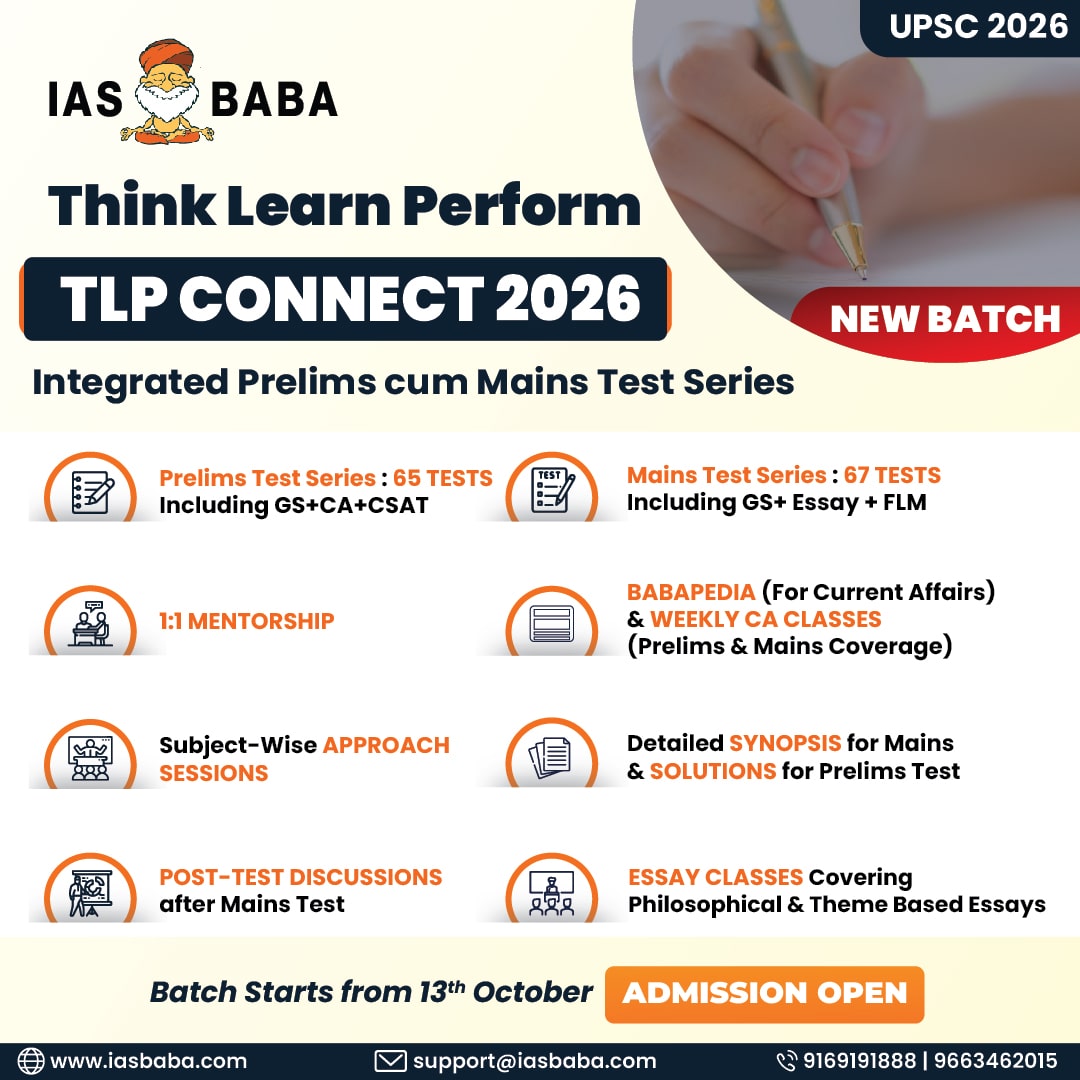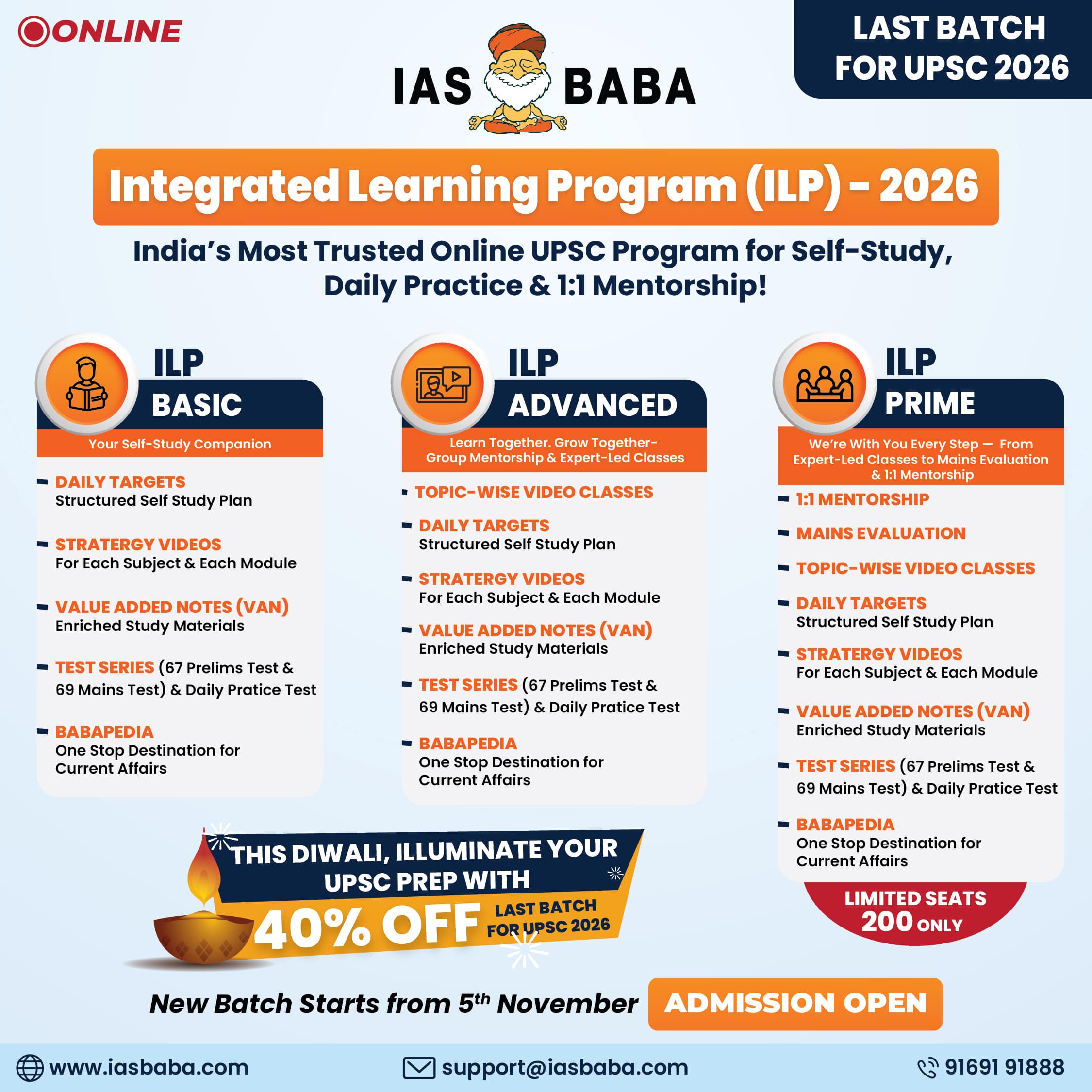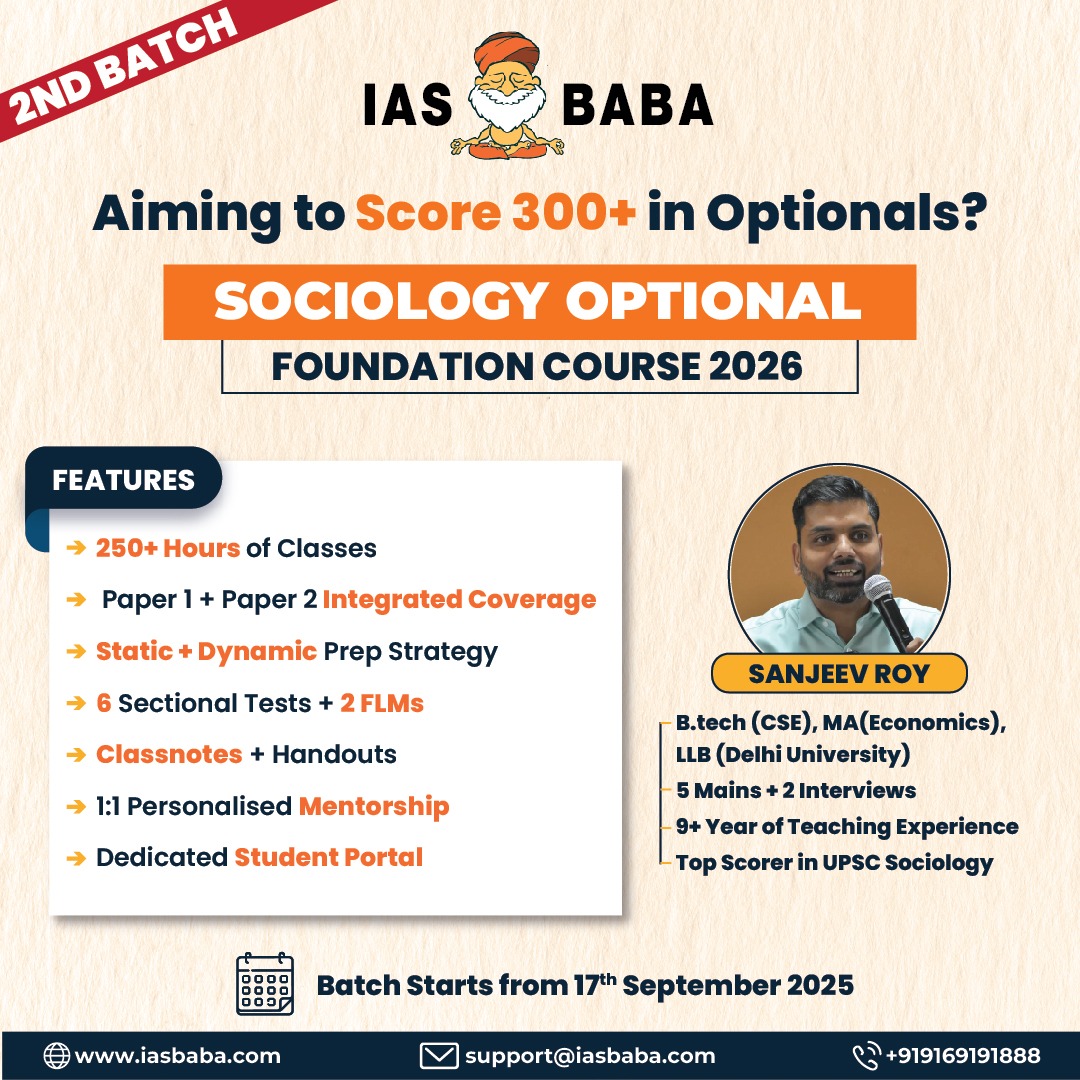IASbaba's Daily Current Affairs Analysis
rchives
(PRELIMS Focus)
Category: SCIENCE AND TECHNOLOGY
Context: India successfully test-fired the Agni-Prime (Agni-P) ballistic missile from a rail-based mobile launcher, marking a strategic milestone.
The Defence Research and Development Organisation (DRDO) tested the Agni-P missile from a rail-based launcher, placing India among a select group of nations with such “canisterised launch systems.” Rail-based platforms enhance second-strike capability by providing mobility, concealment, and survivability against enemy surveillance compared to vulnerable fixed silos. They are cheaper and easier to scale than submarine-based systems, leveraging India’s extensive railway network. Agni-P, a two-stage solid-fuel missile with a range of 1,000–2,000 km, succeeds Agni-I with improved guidance, propulsion, and warhead technology.
Learning Corner:
Agni-P (Agni-Prime) missile:
- Type: New-generation, medium-range ballistic missile (MRBM).
- Developer: Defence Research and Development Organisation (DRDO).
- Range: 1,000 – 2,000 km.
- Propulsion: Two-stage, solid-fuel propulsion system.
- Launch Platforms: Canisterised system—deployable from road and rail-based mobile launchers, enhancing mobility and survivability.
- Features:
- Advanced navigation and guidance system.
- Improved accuracy compared to earlier Agni variants.
- Lighter composite materials, making it more efficient.
- Strategic Importance:
- Enhances India’s second-strike capability.
- Provides flexibility to evade enemy surveillance by using mobile launchers.
- Cheaper alternative compared to submarine-launched ballistic missiles (SLBMs).
- Successor: Designed as a successor to Agni-I with modernised systems.
Integrated Guided Missile Development Programme (IGMDP)
- Launch: 1983, by DRDO, under the leadership of Dr. A.P.J. Abdul Kalam.
- Aim: To make India self-reliant in missile technology and develop a series of indigenous guided missiles.
- Significance: Reduced dependence on foreign technology (especially due to MTCR restrictions), created a strong base for future missile projects, and strengthened India’s defence preparedness.
- Closure: Officially declared completed in 2008, after most projects achieved their objectives.
Missiles Developed under IGMDP
- Prithvi – Surface-to-surface short-range ballistic missile (SRBM); first missile developed under IGMDP.
- Agni – Initially a technology demonstrator for re-entry vehicles; later evolved into a family of medium to intercontinental range ballistic missiles (MRBM → ICBM).
- Akash – Medium-range, surface-to-air missile (SAM); inducted into the Indian Air Force and Army.
- Trishul – Short-range, quick-reaction surface-to-air missile; served mainly as a technology demonstrator.
- Nag – Third-generation, fire-and-forget anti-tank guided missile (ATGM); inducted after extensive trials.
Source: THE INDIAN EXPRESS
Category: POLITY
Context : The Supreme Court struck down Rajasthan’s 2007 VAT exemption on locally made goods, ruling that taxation cannot discriminate against goods from other states.
The Supreme Court quashed a Rajasthan notification that exempted VAT on locally manufactured asbestos sheets and bricks, which disadvantaged goods imported from other states. The bench held this violated Article 304(a) of the Constitution, which prohibits states from imposing discriminatory taxes on out-of-state goods. The Court emphasized that taxation cannot be used as a tool to restrict trade or create unfair advantages for local products, reaffirming the principle of free and non-discriminatory trade across India.
Learning Corner:
Article 304(a) of the Constitution:
- Provision: Article 304(a) of the Indian Constitution allows State Legislatures to impose taxes on goods imported from other States or Union Territories, but such taxation cannot discriminate between imported goods and similar goods produced within the State.
- Objective: To ensure free trade, commerce, and intercourse throughout India (as guaranteed under Article 301) while permitting States to levy taxes for revenue purposes.
- Key Principle: Taxes must be non-discriminatory—i.e., goods from other States should not be treated unfavorably compared to locally produced goods.
- Judicial Interpretation: The Supreme Court has consistently held that taxation cannot be used as a weapon to create economic barriers or protectionism within a State. Discriminatory tax laws violate the spirit of national economic unity.
Source: THE INDIAN EXPRESS
Category: INTERNATIONAL
Context: India and Russia are exploring a BRICS grain exchange plan to strengthen agricultural trade cooperation.
Prime Minister Narendra Modi met Russian Deputy Prime Minister Dmitry Patrushev in New Delhi during the World Food India 2025 event, where they discussed creating a common BRICS agricultural food exchange to boost trade in food, fertilizers, and processing. The talks also covered the ongoing Free Trade Agreement between India and the Eurasian Economic Union. Both leaders reaffirmed their commitment to deepening India-Russia ties, highlighting growing bilateral trade, which saw record levels in 2024. Russia emphasized its “special and privileged” partnership with India, while India conveyed greetings to President Putin ahead of the upcoming India-Russia summit.
Learning Corner:
BRICS
- Full Form: BRICS stands for Brazil, Russia, India, China, and South Africa.
- Origin: Started as BRIC in 2006 (Brazil, Russia, India, China); South Africa joined in 2010, making it BRICS.
Current Members (11 as of 2025)
- Original Five: Brazil, Russia, India, China, South Africa
- New Members (2024): Egypt, Ethiopia, Iran, Saudi Arabia, United Arab Emirates
- Newest Member (2025): Indonesia
Nature and Weight
- Represents over 40% of the world’s population and a growing share of global GDP (PPP), surpassing the G7.
- Functions as an informal grouping of emerging economies, not a treaty-based organisation.
Objectives
- Promote multipolarity in international politics.
- Reform global institutions like the UN, IMF, and World Bank to reflect the voices of developing nations.
- Strengthen cooperation in trade, finance, energy, agriculture, technology, health, and security.
- Promote South-South cooperation and de-dollarisation in global trade.
Key Institutions and Mechanisms
- New Development Bank (NDB): Finances infrastructure and sustainable development projects.
- Contingent Reserve Arrangement (CRA): Provides liquidity support during balance of payment crises.
- BRICS Pay: Digital payment initiative to reduce dependence on the US dollar.
- BRICS Vaccine R&D Centre: Cooperation on medical research and vaccines.
Source: THE HINDU
Category: POLITY
Context Leh is under curfew after violent protests over Ladakh’s statehood demand left four people dead and dozens injured
Following violent clashes in Leh, where four protesters were killed and many injured, authorities imposed a strict curfew and detained dozens of people. The bodies were handed over to families for last rites, with the Ladakh Buddhist Association involved in arrangements. Protests, led by activists including Sonam Wangchuk, are pressing for statehood and Ladakh’s inclusion under the Sixth Schedule. Meanwhile, Kargil observed a complete shutdown in solidarity. The Union Home Ministry has cancelled the FCRA registration of Wangchuk’s organisation for alleged violations. Political groups accused authorities of using excessive force, while the Centre has called for a preparatory dialogue with local representatives.
Learning Corner:
FCRA (Foreign Contribution Regulation Act):
- Origin: First enacted in 1976, comprehensively amended in 2010, with further changes in 2020.
- Objective: To regulate the acceptance and utilisation of foreign contributions (donations, funds, hospitality) by individuals, associations, and NGOs in India.
- Purpose:
- Prevent misuse of foreign funds that may affect national security, sovereignty, or public interest.
- Ensure transparency and accountability in the use of such contributions.
- Key Provisions:
- Organisations must obtain FCRA registration from the Ministry of Home Affairs (MHA) to legally receive foreign funds.
- Funds can only be received in a designated FCRA bank account (currently at SBI, New Delhi main branch).
- Restrictions on transfer of foreign funds to other NGOs.
- Mandatory disclosure of receipts and expenditure.
- Prohibitions: Political parties, candidates for election, government servants, judges, journalists of specified media, and organisations of political nature cannot receive foreign contributions.
- Recent Issues: Licenses of several NGOs have been suspended or cancelled over alleged violations, sparking debates on balancing national security with civil society freedom.
Source: THE HINDU
Category: ECONOMICS
Context: Outward remittances under RBI’s Liberalised Remittance Scheme (LRS) fell 11% in July 2025 to $2.45 billion due to lower spending on travel and education abroad.
According to RBI data, outward remittances by resident individuals in July 2025 stood at $2,452.93 million, down from $2,754.05 million a year earlier. The decline was mainly due to reduced spending on travel ($1,445.34 million) and studies abroad ($229.25 million). However, remittances towards equity/debt investments, deposits, and immovable property purchases saw an increase. For FY 2024–25, total outward remittances under LRS reached $29.56 billion. Introduced in 2004 with an initial limit of $25,000, the scheme now allows remittances up to $250,000 annually in line with global economic trends.
Learning Corner:
Liberalised Remittance Scheme (LRS):
- Introduction: Launched by the Reserve Bank of India (RBI) in 2004, the Liberalised Remittance Scheme allows resident individuals to remit money abroad for permitted current and capital account transactions.
- Limit: Initially capped at USD 25,000 per financial year, it has been gradually increased in line with global trends. The current limit is USD 250,000 per individual per financial year.
- Permitted Uses:
- Education and living expenses abroad
- Medical treatment
- Travel (private or business)
- Purchase of immovable property abroad
- Investments in shares, debt instruments, or mutual funds
- Gifts and donations
- Prohibited Uses:
- Remittances for margin trading, lottery, gambling, or banned activities
- Remittances to countries identified as non-cooperative by FATF or where transactions are restricted by RBI
- Monitoring: Banks must ensure compliance with LRS rules, and PAN is mandatory for all remittances under this scheme.
Source: THE HINDU
(MAINS Focus)
Introduction (Context)
India’s export economy is heavily skewed, with Gujarat, Maharashtra, Tamil Nadu, and Karnataka accounting for over 70% of exports while populous states like UP, Bihar, and MP together contribute barely 5%.
Despite sharing 5,400 km of international borders, the northeastern states remain almost absent from the trade map, with just 0.13% of exports, reflecting a critical neglect of regions vital for a balanced economy.
Marginalisation of the Northeast
- No operational trade corridor links the region to foreign markets.
- Presence of no logistical infrastructure to support volume or role in shaping policy. Instead there is the existence of security apparatus calibrated for counterinsurgency and surveillance.
- Key export policies and schemes like Remission of Duties and Taxes on Exported Products and Production-Linked Incentives are designed for industrial belts in western and southern India.
- Institutions shaping India’s export strategy e.g., PM’s Economic Advisory Council lack representation from the Northeast.
- The Board of Trade, tasked with steering India’s export strategy, has no substantive voice from Mizoram, Tripura, or Arunachal Pradesh
- DGFT’s 2024 export plan of 87 pages carried no substantive section on the Northeast.
- Assam’s tea economy, producing over half of India’s tea, faces stagnant prices, labour shortages, and exposure to Western tariff hikes.
- Numaligarh refinery expansion increases dependence on Russian cargoes, making it vulnerable to geopolitical sanctions.
India-Myanmar relations
- Since the 2021 coup in Myanmar, trade across the India–Myanmar border has sharply declined, with once-active highways now reduced to checkpoints and bureaucratic delays.
- Key gateways Zokhawthar (Mizoram) and Moreh (Manipur) have become securitised bottlenecks instead of trade hubs, lacking proper roads, customs staff, and cold-chain facilities.
- The 2024 scrapping of the Free Movement Regime severed cross-border trade, kinship ties, and local hill economies.
- Surveillance has replaced commerce, turning trade corridors into containment zones where troops move but goods do not.
- The Northeast, once envisioned as India’s bridge to ASEAN, remains excluded from national trade strategy, with policy still focused on traditional western and southern export corridors.
- The India–Myanmar–Thailand Trilateral Highway remains incomplete and underutilised.
While China consolidates influence in northern Myanmar through infrastructure and alliances, India’s Act East policy remains largely rhetorical. The absence of trade infrastructure cedes economic and strategic ground to regional competitors.
Implications
- India’s exports are concentrated in a few coastal states, so even a natural disaster in Gujarat or a labour strike in Tamil Nadu can disturb the entire national export chain.
- Leaving the Northeast out of trade planning weakens India’s influence in Southeast Asia and limits its role in the wider Indo-Pacific region.
- Continuous neglect of the region increases feelings of isolation, reducing job opportunities and fuelling resentment among local communities.
Way Forward
- Build strong basic infrastructure like highways, warehouses, cold storage and border trade facilities instead of relying only on policy announcements.
- Give the Northeast proper representation in export policy bodies so that its needs and opportunities are part of national trade decisions.
- Activate projects like the India–Myanmar–Thailand Highway and reopen key cross-border trade routes with ASEAN to connect the region to foreign markets.
- Encourage industries to set up export units in border states by offering targeted PLI schemes, tax incentives, and logistics support.
- Treat trade geography as part of national security planning to counter China’s growing influence in Myanmar and the Bay of Bengal.
Conclusion
India cannot aspire to regional leadership while its eastern flank stays economically weak. True resilience demands spreading trade opportunities nationwide and giving the Northeast real infrastructure, policies, and market access, not just symbolic inclusion.
Mains Practice Question
Q Why does India’s Northeast contribute so little to exports, and how can the region be better integrated into the national trade strategy? (250 words, 15 marks)
Introduction
River pollution continues to be a critical environmental and public health issue in India. Polluted rivers affect aquatic ecosystems, compromise water quality, and threaten livelihoods dependent on rivers.
CPCB has recently released data on river pollution, hereby discussing the key findings.
Key findings
- CPCB reviewed water quality data from 2,116 locations across 32 states and Union Territories (2022–2023) and found 296 polluted river stretches on 271 rivers. The number has marginally decreased from 311 in the previous report.
- Priority I (most polluted): Out of 296 stretches, 37 were classified as critically polluted (BOD > 30 mg/L), slightly lower than 46 in the previous report.
- State-wise distribution: Tamil Nadu, Uttar Pradesh, and Uttarakhand reported the highest number (five each) of Priority I stretches; Gujarat (four) and Karnataka (three) also featured prominently.
- Notable polluted stretches: Yamuna (Palla–Asgarpur, Delhi), Sabarmati (Ahmedabad), Chambal (Nagda–Gandhisagar, MP), Tungabhadra (Karnataka), Sarabanga (Tamil Nadu).
- Rivers with deteriorated water quality: Jhelum (J&K), Ganga, Ramrekha, Sikrahna (Bihar), Hasdeo, Mahanadi (Chhattisgarh), Sal, Mapusa (Goa), Cauvery, Tungabhadra (Karnataka), Periyar (Kerala), Amba, Savitri (Maharashtra), Krishna (Telangana), Kosi (Uttarakhand).
- Maharashtra has the highest number (54) of polluted river stretches.
Terminologies
- Biochemical Oxygen Demand (BOD): BOD measures the amount of oxygen required by microorganisms to decompose organic matter in water. Locations with BOD > 3 mg/L are considered polluted and unsuitable for bathing.
- Polluted River Stretch: It is the continuous sequence of two or more polluted locations along a river. High BOD levels indicate excessive organic and chemical pollution, impacting aquatic life and human health.
- Priority Categories of River Water Quality:
-
- Priority I: Critically polluted (BOD > 30 mg/L)
- Priority II: Severely polluted (BOD 20–30 mg/L)
- Priority III: Moderately polluted (BOD 10–20 mg/L)
- Priority IV: Less polluted (BOD 6–10 mg/L)
- Priority V: Non-polluted (BOD 3–6 mg/L)
- Water (Prevention and Control of Pollution) Act, 1974: Provides a legal framework for preventing and controlling water pollution.
- CPCB: Central body for planning, regulating, and enforcing water quality standards.
- SPCBs: State-level institutions responsible for implementing water quality norms.
- National Water Quality Monitoring Programme (NWQMP): Launched in 1978 under GEMS-Water programme to continuously track water quality across India.
Reasons for River Pollution
- Untreated Sewage: Over 60% of sewage is released untreated into rivers daily, causing severe health risks and ecological damage.
- Industrial Effluents: Toxic wastewater from chemical, sugar, paper, and tannery industries contaminates water with hazardous chemicals.
- Agricultural Runoff: Pesticides, fertilizers, and nutrient-rich runoff increase BOD levels and cause eutrophication.
- Sand Mining and Illegal Encroachment: Disrupt natural river flow, increase flood risk, and contribute to sediment and pollutant accumulation.
- Other Factors: Solid waste dumping, urbanisation along riverbanks, and lack of proper drainage infrastructure.
Impact of River Pollution
- Environmental Impact: Loss of aquatic biodiversity, ecosystem degradation, and altered river morphology.
- Health Impact: Waterborne diseases like cholera, diarrhea, and skin infections among communities dependent on rivers
- Economic Impact: Reduced agricultural productivity, fisheries decline, and increased water treatment costs.
- Social Impact: Disruption of cultural and religious practices tied to rivers.
Government initiatives
- Namami Gange Programme (NGP): It is the holistic river basin management programme to abate pollution and restore Ganga’s ecological health through sewage treatment, riverfront development, and community participation.
- Yamuna Action Plan (YAP): Focuses on reducing Yamuna pollution via sewage treatment, industrial effluent control, and inter-state coordination.
- State-level river rejuvenation schemes: Programs like Mukhyamantri Jal Samvardhan Yojana clean local rivers and prevent untreated sewage discharge.
- Industrial effluent regulation: CPCB and SPCBs monitor and enforce wastewater treatment norms for industries.
- Real-time water quality monitoring: Sensor-based and GIS-linked systems track BOD, COD, and other parameters for timely intervention.
- Agricultural runoff management: Promotes organic farming, bio-remediation, and controlled use of fertilizers and pesticides.
Challenges
- Inadequate sewage treatment and poor infrastructure result in untreated sewage entering rivers.
- Insufficient enforcement of industrial effluent norms leads to continued chemical contamination.
- Agricultural runoff with fertilizers and pesticides increases nutrient load, causing eutrophication.
- Rapid urbanisation, sand mining, and encroachments disrupt river flow and add to pollution.
- Inter-state coordination issues hinder comprehensive river management.
- Lack of public awareness and limited community participation slows pollution control efforts.
Way Forward
- Strengthen sewage and industrial wastewater treatment infrastructure and ensure strict enforcement of laws.
- Promote river basin management with inter-state coordination and scientific monitoring.
- Encourage community engagement, public awareness campaigns, and adoption of sustainable farming practices.
- Implement real-time water quality monitoring and early warning systems for timely interventions.
- Expand programmes like Namami Gange and Yamuna Action Plan to cover more rivers and stretches.
Conclusion
River pollution in India continues to threaten ecosystems, public health, and livelihoods. Despite slight improvements, effective pollution control requires strict law enforcement, technology-driven monitoring, and active community participation to restore rivers and secure water resources.
Mains Practice Question
Q Examine the major causes and impacts of river pollution in India. Evaluate the effectiveness of government initiatives and suggest measures to improve river water quality. (250 words, 15 marks)














